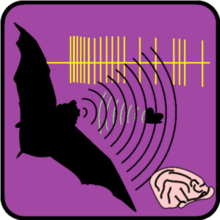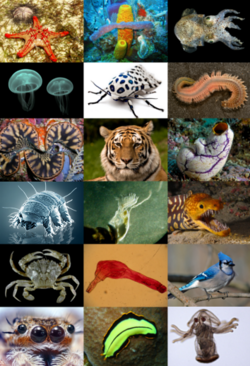神經行為學
外觀

| 動物學系列 |
| 動物學分支 |
|
人類學 · 人與動物關係學 |
| 歷史 |
神經行為學(Neuroethology),名稱源自希臘文νεῦρον(神經)與ἦθος(行為),是通過演化與比較等方法對動物行為及其神經系統機制進行研究的學科。[1][2][3]它是行為神經科學的一門交叉學科分支,目的是了解中樞神經系統如何將刺激轉化為自然行為。例如,蝙蝠的聽覺系統是如何將聲音的聲學性質轉化以進行回聲定位的。[4]神經行為學家希望通過對於動物的特殊行為的研究得到神經系統的普遍規律。
正如學科名稱所表示的那樣,這門學科是神經科學與行為學的綜合。與神經科學的其他分支相比,神經行為學的一個中心主題是注重於對自然行為的研究。其中自然行為是指源自自然選擇過程的行為(如求偶、飛行、行走、躲避掠食者等),而非處於疾病狀態的行為,或特別是在實驗室條件下的任務行為。
歷史
[編輯]神經行為學的領域欠它的存在的一部分,建立動物行為學的是動物學內部的獨特的學科。雖然動物的行為已經早在亞里斯多德(公元前384-342)的時代就曾進行了研究,但直到二十世紀早期,動物行為學才終於成為從自然科學(一個嚴格的描述領域)和生態學區分開來的一門學科。這背後的新的區別主要的催化劑是康拉德·洛倫茲和尼古拉斯·廷貝亨的研究和著作。
模式系統
[編輯]- 蝙蝠的回聲定位 - 夜間飛行導航和捕獲獵物;使用其自己的叫聲的回應返回對象的位置。
- 鳴禽唱歌 - 斑胸草雀,金絲雀,和白冠帶鵐,歌曲學習作為人類語言發展的一種模式。
- 晝夜節律 - 視交叉上核的各種晝夜控制行為的影響。
- 蟋蟀唱歌 - 求偶鳴聲。
- 夜蛾科 - 對於蝙蝠叫聲的超音波迴避反應
- 老鼠 - 空間記憶和導航。
- 蜜蜂屬 - 學習,導航,視覺,嗅覺,飛行,攻擊,覓食。
- 淡水龍蝦 - 逃跑,驚跳行為,侵略和社會等級的形成。
- 慈鯛科魚 - 侵略和攻擊行為。
- 君主斑蝶 - 導航機制。
參閱
[編輯]注釋
[編輯]- ^ Hoyle, G. (1984) The scope of Neuroethology. The Behavioral and Brain Sciences. 7:367-412.
- ^ Ewert, P. (1980) Neuroethology. Springer-Verlag. New York.
- ^ Camhi, J. (1984) Neuroethology. Sinauer. Sunderland Mass.
- ^ Suga, N. (1989). "Principles of auditory information-processing derived from neuroethology." J Exp Biol 146: 277-86.
參考文獻
[編輯]- Beer D., Randall, Roy E. Ritzmann, Thomas McKenna (1993) Biological neural networks in invertebrate neuroethology and robotics. Boston : Academic Press.
- Camhi, J.M. (1984) Neuroethology: Nerve cells and the Natural behavior of Animals, Sinauer Associates.
- Carew, T.J. (2000) Feature analysis in Toads. Behavioral Neurobiology, Sunderland, MA: Sinauer, pp. 95–119.
- Carew, T.J. (2000) Behavioral neurobiology: The Cellular Organization of Natural Behavior, Sinauer Associates.
- Ewert, J.-P. (1974) The neural basis of visually guided behavior. Scientific American 230(3):34-42
- Ewert J.-P. (2004) Motion perception shapes the visual world of amphibians. In: Prete F.R. (Ed.) Complex Worlds from Simpler Nervous Systems. Cambridge, MA, MIT Press, pp. 117–160
- Hoyle, G. (1984) The scope of Neuroethology. Behavioural Brain Science 7:367-412. Graham Hoyle put forth a rather narrow definition of the goals and subject matter of neuroethology and links the field to the field of ethology. This is followed by commentaries from many prominent neuroethologists. It makes for fascinating reading.
- Metzner, W. (1993) The Jamming avoidance response in Eigenmannia is controlled by two separate motor pathways. The Journal of Neuroscience. 13(5):1862-1878
- Pfluger, H.-J. and R. Menzel (1999) Neuroethology, its roots and future. J Comp Physiol A 185:389-392.
- Zupanc, G.K.H. (2004) Behavioral Neurobiology: An Integrative Approach. Oxford University Press: Oxford, UK.


